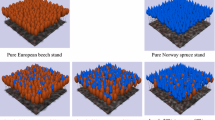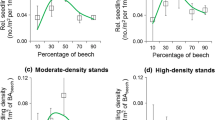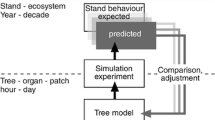Abstract
The temperate, humid climate and nutrient-rich soils in the pre-alpine areas of southern Bavaria represent conditions where European beech and Norway spruce come out with rather equal above ground biomass production when cultivated in pure stands. In order to reveal the effect of mixture we established 37 experimental plots in even-aged pure and mixed stands of Norway spruce and European beech covering an age span of 37–155 years. The site conditions ranged from warm, dry and base-rich to cool, wet and acidic sites. The ratio of above ground biomass growth of Norway spruce in relation to European beech decreases from 1.14:1 in the monocultures to 1.04:1 in the mixed stands. The mixing of spruce and beech results in a mutual stimulation of biomass production and acceleration of size growth. Together both species produce up to 59% more above ground biomass than the neighboring pure stands. On average the overyielding amounts to 21% in the case of Norway spruce and 37% in the case of European beech. A total of 67% out of the plots indicate overyielding and 57% transgressive overyielding. In mixed stands both species’ tree sizes are significantly ahead of the corresponding pure stands. Facilitation of spruce and competitive reduction of beech yields mutualism with respect to growth on tree and stand level. Consequences for analyzing and modeling interspecific competition and for silvicultural prescriptions are discussed. Ecological implications of the mixing effect on the occurrence and stability of natural and man-made mixed stands of spruce and beech are considered.








Similar content being viewed by others
References
Assmann E (1961) Waldertragskunde. Organische Produktion, Struktur, Zuwachs und Ertrag von Waldbeständen. BLV Verlagsgesellschaft, München
Assmann E, Franz F (1965) Vorläufige Fichten-Ertragstafel für Bayern. Forstw Cbl 84:13–43
Begon ME, Townsend CR, Harper JL (1998) Ökologie. Spektrum Akademischer Verlag, Heidelberg, pp 329–355
Bolte A, Villanueva I (2006) Interspecific competition impacts on the morphology and distribution of fine roots in European beech (Fagus sylvatica L.) and Norway spruce (Picea abies (L.) Karst.). Eur J Forest Res 125(1):15–26
Bristow M, Vanclay JK, Brooks L, Hunt H (2006) Growth and species interactions of Eucalyptus pellita in a mixed and monoculture plantation in the humid tropics of north Queensland. For Ecol Manage 233(2–3):285–294
Burger H (1941) Beitrag zur Frage der reinen oder gemischten Bestände. Mitt Schweiz Anst Forstl Versuchswesen 22:164–203
Cannell MGR, Malcom DC, Robertson PA (1992) The ecology of mixed-species stands of trees. Blackwell, Oxford
Cotta Hv (1828) Anweisung zum Waldbau. Arnoldische Buchhandlung, Dresden
Dhôte JF (2004) Implication of forest diversity for the resistance to strong winds. In: Scherer-Lorenzen M, Körner CH, Schulze ED (eds) Forest diversity and function, Ecol Stud 176
Dietrich V (1927) Über den Einbau des Nadelholzes in Laubholgebieten. Forstl. Wochenschrift Silva 15:285–291, 295–297
Dietrich V (1928) Untersuchungen in Mischbeständen. Mitt Württemb Forstl Versuchsanstalt 1:25–34
Ellenberg H (1963) Vegetation Mitteleuropas mit den Alpen: in kausaler, dynamischer und historischer Sicht. Verlag Eugen Ulmer, Stuttgart
Flury Ph (1926) Über Zuwachs und Ertrag reiner und gemischter Bestände. Schweiz Z Forstw 77:337–342
Flury Ph (1931) Untersuchungen über Zuwachs, Massen- und Geldertrag reiner und gemischter Bestände. Mitt Schweiz Anst Forstl Versuchswesen 16:452–472
Frivold LH, Frank J (2002) Growth of mixed birch-coniferous stands in relation to pure coniferous stands at similar sites in south-eastern Norway. Scan J For Res 17:139–149
Gayer K (1886) Der gemischte Wald, seine Begründung und Pflege, insbesondere durch Horst- und Gruppenwirtschaft. Paul Parey, Berlin
Hartig GL (1791) Anweisung zur Holzzucht für Förster. Neue Akademische Buchhandlung, Marburg
Hartig GL (1804) Anweisung zur Taxation und Beschreibung der Forste. Gießen und Darmstadt, bey Georg Friedrich Heyer
Helms JA (1998) The dictionary of forestry. The society of American foresters, Bethesda
Hofmann F (1923) Mischungen von Buchen mit Nadelholz, insbesondere mit der Fichte und Tanne. Allg Forst- u Jagdztg 99:273–281
Keller W (1995) Zur Oberhöhenberechnung in Mischbeständen aus standortkundlicher Sicht. Bericht der Jahrestagung der Sektion Ertragskunde im Deutschen Verband Forstlicher Forschungsanstalten 1995 in Joachimsthal, pp 52–60
Kelty MJ (1992) Comparative productivity of monocultures and mixed stands. In: Kelty MJ, Larson BC, Oliver CD (eds) The ecology and silviculture of mixed-species forests. Kluwer, Dordrecht, pp 125–141
Kennel R (1965) Untersuchungen über die Leistung von Fichte und Buche im Rein- und Mischbestand. Allg Forst- u Jagdztg 136:149–161, 173–189
Knoke Th, Stimm B, Ammer Ch, Moog M (2005) Mixed forests reconsidered: a forest economics contribution on an ecological concept. For Ecol Manage 213:102–116
Knoke Th, Seifert Th (2007) Integrating selected ecological effects of mixed European beech–Norway spruce stands on bioeconomic modelling. Ecol Modell. doi:10.1016/j.ecolmodel.2007.08.011
Körner Ch (2002) Grundlagen der Pflanzenökologie. In: Sitte P, Weiler EW, Kadereit JW, Bresinsky A, Körner Ch (eds) Strasburger, Lehrbuch der Botanik, Spektrum Akademischer Verlag, Gustav Fischer, Heidelberg, pp 889–1043
Kramer H (1988) Waldwachstumslehre. Paul Parey, Hamburg
Larcher W (2003) Physiological plant ecology, 4th edn. Springer, Berlin
Lyr H, Polster H, Fiedler HJ (1967) Gehölzphysiologie. VEB Gustav Fischer Verlag, Jena, p 337
Mettin Ch (1985) Betriebswirtschaftliche und ökologische Zusammenhänge zwischen Standortskraft und Leistung in Fichtenreinbeständen und Fichten/Buchen-Mischbeständen. AFZ 40:803–810
Mielikäinen K (1985) Koivusekoituksen Vaikutus Kuusikon Rakenteeseeen ja kehitykseen. Effect of an admixture of birch on the structure and development of Norway Spruce Stands. Commun Inst For Fenn 133:1–79
Mitscherlich G (1970) Wald, Wachstum und Umwelt, vol 1. Form und Wachstum von Baum und Bestand, J. D. Sauerländer’s Verlag, Frankfurt, p 142
Möller A (1922) Der Dauerwaldgedanke. Sein Sinn und seine Bedeutung. Verlag Julius Springer, Berlin
Olsthoorn AFM, Bartelink HH, Gardiner JJ, Pretzsch H, Hekhuis HJ, Franc A (eds) (1999) Management of mixed-species forest: silviculture and economics. IBN Scientific Contributions 15
Piotto D (2007) A meta-analysis comparing tree growth in monocultures and mixed plantations. For Ecol Manage. doi:10.1016/j.foreco.2007.09.065
Pretzsch H (1992) Konzeption und Konstruktion von Wuchsmodellen für Rein- und Mischbestände, Forstliche Forschungsberichte München, 115, München
Pretzsch H (2001) Modellierung des Waldwachstums. Blackwell, Berlin
Pretzsch H (2002) Grundlagen der Waldwachstumsforschung. Blackwell, Berlin
Pretzsch H (2003) The elasticity of growth in pure and mixed stands of Norway spruce (Picea abies [L.] Karst.) and common beech (Fagus sylvatica L.). J For Sci 49:491–501
Pretzsch H (2005) Diversity and productivity in forests. In: Scherer-Lorenzen M, Körner Ch, Schulze ED (eds) (2005) Forest diversity and function. Ecological Studies, vol 176. Springer, Heidelberg, pp 41–64
Pretzsch H (2006) Species-specific allometric scaling under self-thinning. Evidence from long-term plots in forest stands. Oecologia 146:572–583
Pretzsch H, Biber P (2005) A re-evaluation of Reineke’s rule and stand density index. For Sci 51(4):304–320
Pretzsch H, Schütze G (2005) Crown allometry and growing space efficiency of Norway spruce (Picea abies (L.) Karst.) and European beech (Fagus sylvatica L.) in pure and mixed stands. Plant Biol 7:628–639
Pretzsch H, Mette T (2008) Linking stand-level self-thinning allometry to the tree-level leaf biomass allometry. Trees. doi:10.1007/s00468-008-0231-x
Pretzsch H, Kahn M, Grote R (1998) Die Fichten-Buchen-Mischbestände des Sonderforschungsbereiches "Wachstum oder Parasitenabwehr?” im Kranzberger Forst. Forstw Cbl 117:241–257
Prinz R (2007) Bestandeswachstum und Kronenstruktur in Fichten-Buchen-Mischwäldern. Analyse der Wuchsreihe Schongau 814. Diploma thesis, Technische Universität München, Freising Weihenstephan
Reineke LH (1933) Perfecting a stand density index for even-aged forests. JAgric Res 46:627–638
Rötzer T, Seifert T, Pretzsch H (2008) Modelling above and below ground carbon dynamics in a mixed beech and spruce stand influenced by climate. Eur J Forest Res. doi:10.1007/s10342-008-0213-y
Roloff A (2001) Baumkronen. Verlag Eugen Ulmer, Stuttgart
Rothe A (1997) Einfluß des Baumartenanteils auf Durchwurzelung, Wasserhaushalt, Stoffhaushalt und Zuwachsleistung eines Fichten-Buchen-Mischbestandes am Standort Höglwald. Forstliche Forschungsberichte München, 163, München
Rothe A, Binkley D (2001) Nutritional interactions in mixed species forests: a synthesis. Can J For Res 31:1855–1870
Schmid I (2002) The influence of soil type and interspecific competition on the fine root system of Norway spruce and European beech. Basic Appl Ecol 3(4):339–355
Schmid I, Kazda M (2002) Root distribution of Norway spruce in monospecific and mixed stands on different soils. For Ecol Manage 159:37–47
Scherer-Lorenzen M, Körner Ch, Schulze ED (eds) (2005) Forest diversity and function. In: Ecological studies, vol 176. Springer, Berlin
Schober R (1967) Buchen-Ertragstafel für mäßige und starke Durchforstung, In: Die Rotbuche 1971, J. D. Sauerländer’s Verlag, Frankfurt a. Main, 1972, Schriften aus der Forstlichen Fakultät der Universität Göttingen und der Niedersächsischen Forstlichen Versuchsanstalt 43/44
Schulze ED, Beck E, Müller-Hohenstein K (2002) Plant ecology. Springer, Berlin
Schwappach A (1909) Untersuchungen in Mischbeständen. Zeitschr f Forst- u Jagdw 41:313–332
Seifert T, Müller-Starck G (2008) Impacts of fructification on biomass production and correlated genetic effects in Norway spruce (Piecea abies [L.] Karst.). Eur J Forest Res. doi:10.1007/s10342-008-0219-5
Spellmann H (1996) Leistung und Windstabilität von Fichten-Buchen-Mischbeständen. Bericht von der Jahrestagung der Sektion Ertragskunde im Deutschen Verband Forstlicher Forschungsanstalten, Neresheim, pp 46–56
Trendelenburg R, Mayer-Wegelin H (1955) Das Holz als Rohstoff. Carl Hansa Verlag, München
Wiedemann E (1942) Der gleichaltrige Fichten-Buchen-Mischbestand. Mitt a Forstwirtschaft u Forstwissenschaft 13:1–88
Wiedemann E (1943) Der Vergleich der Massenleistung des Mischbestandes mit dem Reinbestand. Allg Forst- u Jagdztg 119:123–132
Wimmenauer K (1914) Zur Frage der Mischbestände. Allg Forst- u Jagdztg 90:90–93
Zimmerle H (1949) Zur Mischbestandsfrage. Allg Forst- u Jagdztg 121:20–29
Acknowledgments
The authors wish to thank the Deutsche Forschungsgemeinschaft for providing funds for mixed stands research as part of the Sonderforschungsbereich SFB 607 “Growth and Parasite Defense” and the Bavarian State Ministry for Agriculture and Forestry for permanent support of the forest yield science project W 07 “Long-term experimental plots for growth and yield research”. Thanks are also due to Dr. Peter Biber for support of the statistical analysis, Ulrich Kern for the graphical artwork, Prof. Dr. Andreas Bolte for thorough review, and anonymous reviewers, for their constructive criticism.
Author information
Authors and Affiliations
Corresponding author
Additional information
Communicated by A. Roloff.
This article belongs to the special issue. “Growth and defence of Norway spruce and European beech in pure and mixed stands”.
Rights and permissions
About this article
Cite this article
Pretzsch, H., Schütze, G. Transgressive overyielding in mixed compared with pure stands of Norway spruce and European beech in Central Europe: evidence on stand level and explanation on individual tree level. Eur J Forest Res 128, 183–204 (2009). https://doi.org/10.1007/s10342-008-0215-9
Received:
Revised:
Accepted:
Published:
Issue Date:
DOI: https://doi.org/10.1007/s10342-008-0215-9




